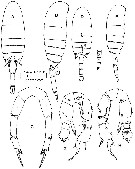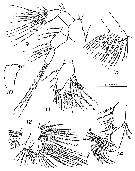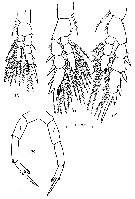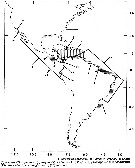|
|
 |
|
Calanoida ( Order ) |
|
|
|
Diaptomoidea ( Superfamily ) |
|
|
|
Pseudodiaptomidae ( Family ) |
|
|
|
Pseudodiaptomus ( Genus ) |
|
|
| |
Pseudodiaptomus wrighti Johnson, 1964 (F,M) | |
| | | | | | | Syn.: | Pseudodiaptomus acutus leptopus Löffler,1963;
P. galapagensis : Arcos, 1978 | | | | Ref.: | | | Johnson, 1964 (p.34, figs.F,M, ? no M variant); Walter, 1989 (p.612, Redescr.F,M, figs.F,M; Rem.) |  issued from : T.C. Walter in Bull. Mar. Sc., 1989, 45 (3). [p.613, Fig.12]. Female: A, habitus (dorsal); B, idem (lateral right side); C, P5 (anterior view). sp = spermatophore. Male: D, habitus (dorsal); E, idem (lateral right side); F, urosomal segments 2-3 (ventral view); G, P5 (posterior view); H, idem (anterior view).
|
 issued from : M.W. Johnson in Crustaceana, 1964, 7 (1). [p.35, Figs.1, 2, 3, 5-6, 7]. Female (from Boca de Canisal, Baja California): 1-2, habitus (lateral and dorsal, respectively); 3, genital segment (ventral); 7, rostrum. Nota: Eye bright red. Some specimens show a faint wash of purple on the body and legs. Head fused to the 1st thoracic segment but with a clear demarcation dorsally, 4th and 5th separated. A1 21-segmented.Urosome consists of an asymmetrical conspicuous genital segment followed by 2 fused segments and the free anal segment. It should be mentioned that one adult female over 100 showed a free division between the 1st and 2nd abdominal segmentTwo equal egg sacs occur with a few to 14 eggs each., the eggs are yellowwish-orange. Caudal rami nearly equal in length, and are about 2.5 times as long as broad. Male: 5-6, habitus (dorsal and lateral, respectively). Nota: Right A1 geniculated. Urosome 5-segmented with serrations on the posterior margins of all but the 1st and the anal segment. Caudal rami about twice as long as broad.
|
 issued from : M.W. Johnson in Crustaceana, 1964, 7 (1). [p.37, Figs.9-14]. Female : 9, A2; 10, Md (mandibular blade); 11, Md (mandibular palp); 12, Mx1; 13, Mx2; 14, Mxp.
|
 issued from : M.W. Johnson in Crustaceana, 1964, 7 (1). [p.38, Figs.15-18]. Female: 15, P1; 16, P3; 17, P4; 18, P5.
|
 issued from : M.W. Johnson in Crustaceana, 1964, 7 (1). [p.39, Figs.20, 21, 23-24). Male: 20,right A1; 21, P5 (posterior); 23, variant P5 (posterior; 24, variant P5 (anterior). Nota: P5 asymmetrical; the basipodite 2 of the right leg is relatively long being twice as long as broad and not broadened proximally as in P. acutus; the left leg is the shorter. Three males were found that vary from the common type. In each instance they occurred together with many adult females and males of the common type. These 3 males appear to be indistinguishable from the common males except for some structural differences and larger size of P5. These differences might be sufficiently great to constitute a separate species but for the circumstance of capture together with the common type males and females and the absence of any females deviating sufficiently from the described type. It seems best to consider these differences as a dimorphism in the males. Wright (1936) noted some variations in the left P5 of the male of P. acutus. A dimorphism in the males of certain other calanoid species of this area occurs according to Fleminger (pers. comm.)
| | | | | Compl. Ref.: | | | Dussart & Defaye, 1983 (p.34); Grindley, 1984 (p.226); Brinton & al., 1986 (p.228, Table 1); Walter, 1986 (p.131); 1986 a (p.502, fig.1: zoogeogr.); 1987 (p.366); Suarez-Morales & Gasca, 1998 a (p.111); Lopez-Ibarra & Palomares-Garcia, 2006 (p.63, Tabl. 1, seasonal abundance vs El-Niño, Rem.: p.69, 70 71, 72); Morales-Ramirez & Suarez-Morales, 2008 (p.521); Hernandez-Trujillo & al., 2010 (p.913, Table 2); in CalCOFI regional list (MDO, Nov. 2013; M. Ohman, comm. pers.); Jerez-Guerrero & al., 2017 (p.1046, Table 1: temporal occurrence); Palomares-Garcia & al., 2018 (p.178, Table 1: occurrence) | | | | NZ: | 2 | | |
|
Distribution map of Pseudodiaptomus wrighti by geographical zones
|
| | |  issued from : T.C. Walter in Bull. Mar. Sc., 1989, 45 (3). [p.625, Fig.18]. issued from : T.C. Walter in Bull. Mar. Sc., 1989, 45 (3). [p.625, Fig.18].
Map of American continents showing the zoogeography of Pseudodiaptomus species. |
| | | | Loc: | | | W Baja California (Bahia Magdalena, La Paz), Gulf of California, Central America, Costa Rica (G. of Nicoya), Bahia Cupica (Colombia), Ecuador (G. of Guayaquil), Peru (S-N) | | | | N: | 10 | | | | Lg.: | | | (950) F: 1,38-1,52; M: 1,12-1,30; (1028) F: 1,31-1,61; M: 1,02-1,25; {F: 1,31-1,61; M: 1,02-1,30} | | | | Rem.: | Estuarine and coastal waters.
Incomplete data.
For M.W. Johnson (1964, p.40) the nearest related species known are P. acutus and P. richardi, mainly the first. Both of these occur on the east coast of South America, and together with the present species form a natural group. The species may have evolved from a common stock through isolation by the Isthmus of Panama. The distributional range observed extends from Hipolito Bay (Baja California) to Guayaquil (Ecuador).
In Americanus species group (acutus subgroup) after Walter & al. 2006, p.203. | | | Last update : 13/11/2020 | |
|
|
 Any use of this site for a publication will be mentioned with the following reference : Any use of this site for a publication will be mentioned with the following reference :
Razouls C., Desreumaux N., Kouwenberg J. and de Bovée F., 2005-2025. - Biodiversity of Marine Planktonic Copepods (morphology, geographical distribution and biological data). Sorbonne University, CNRS. Available at http://copepodes.obs-banyuls.fr/en [Accessed December 24, 2025] © copyright 2005-2025 Sorbonne University, CNRS
|
|
 |
 |









